UrbanRail.Net > Europe > Athens
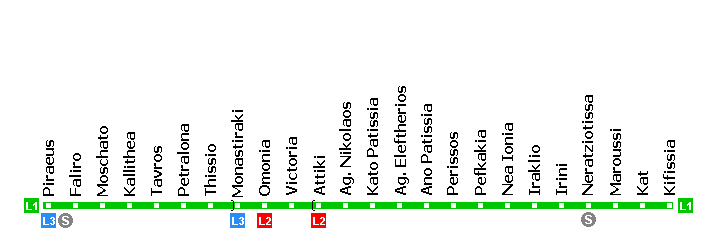
| Line 1 Piraeus - Kifissia | 25.6 km (3 km underground), 24 stations |
|
Given the need to provide a link between the town of Athens and the port of Piraeus, at the time two separate urban centres, the first proposal for a railway to connect the two was put forward by Frederic Ferald as early as 1835, only to be refused. The same answer was given eight years later when Alexandros Rangavis made the same proposal in 1843. However, Prime Minister Alexandros Mavrocordatos passed the Act for the Establishment of the Athens - Piraeus Railway, which cleared the way for the construction of the first ever railway in Greece. It was also the first time the "build-own-operate-hand back" concept was utilised in the country, as the legislation provided that the builders of the line would own and operate it for a period of 55 years, which was later extended to 75 years. In 1867, construction of the railway was awarded to the English businessman Edward Pickering, and work began on the 8 km line from Piraeus to Athens, which terminated at what is today Thissio station. The line was, of course, entirely on the surface and was steam-operated. Construction was completed on 17 February 1869, on which day the first test run took place, with the official opening ceremony following ten days later, during which Queen Olga and Prime-Minister Zaimis were joined by other officials on the first passenger service on the line. The 8-kilometer journey was completed in 19 minutes, and the line at first had no intermediate stations. It closely followed the course of the Long Walls which joined the two towns in ancient times. The journey time is comparable with the present day, although now there are five intermediate stations along this section of the line. The first two of these were opened at Faliro and Moschato in 1882. The original station at Faliro was short-lived, replaced by new premises in 1887. Moschato station has undergone two complete rebuildings during its existence, but still exists on the same site today. Underground to the town centre While better than nothing, the line still terminated short of the heart of Athens, Omonia Square, and parliamentary powers were obtained to extend the line to it. This was to be the first underground stretch of railway in Greece. At first, the line ran eastwards from Thissio, through the remains of the Ancient Athens Market, to Monastirion station (now known as Monastiraki), and then swung northwards, in a cut-and-cover tunnel, to the original Omonia station, which was located beneath Athenas Street. As the line continued to be steam-operated, both Monastirion and Omonia stations were uncovered so that the steam could escape. Service on this extension commenced on 17th May 1895. The experience of travelling underground was unfamiliar and not very welcome by everyone at first, as people were expressing concerns about how save this was. There were reports of people writing their wills or going to church to confess their sins, fearing that they would never complete their journey alive! Electrification Indeed, steam traction on underground railways was far from satisfactory and electrification came in 1904. Multiple-unit trains were introduced for the first time, and it was then that the Athens-Piraeus railway became one of the first Metros in Europe. The trains, albeit being electrically-operated and of the multiple-unit type rather than loco-hauled, were not much different from the loco-hauled coaches they replaced; they had wooden bodies, two passenger doors on each side (power-operated for the first time), high-backed transverse seats and very limited standing space. Initially, they operated in two-car formations, although two or more units could be coupled together to form longer trains. This gives an indication that the areas served by the line were still very rural and passenger numbers limited in comparison with today. Traffic however soon increased, and it became apparent that in its 1890s form, the line would be unable to cope. A major improvement came in 1928 with the opening of the fine new station at Piraeus, an impressive neoclassic building which is still in use today. The same year saw the opening of Kallithea station, to the north-east of Moschato. Out to the suburbia In 1926, Greek Electric Railways S.A., a new company which was created by the co-operation of Attica Railways S.A. and the Power Group from England, took over operation of the line between Piraeus and Omonia. Attica Railways was also running a suburban line from Lavrio Square, to the north of Omonia Square, to Iraklio in northern Athens. It involved a section of street running, along the present 3rd September Street, from Lavrio Square to Attiki Square, beyond which it ran on a dedicated trackbed. At Iraklio, the line forked to form two suburban branches. One went further north via Maroussi to Kifissia, while the other ran eastwards to Vrilissia (at a point very near to the present Plakentias station) and then southwards to Peania, Koropi, Marcopoulo, Kalyvia, Keratea, Kamariza and its terminus at Lavrio. On the way, it passed the very first railway tunnel in Greece, near Kamariza. Most of this line is today abandoned, although sections of the trackbed survive in various places, as does the erstwhile station buildings at Peania (which is now a nursery), Marcopoulo (where some of the old steam locomotives are preserved) and Lavrio. The councils of Marcopoulo and Lavrio have since restored a part of the line for Sunday pleasure workings. The steam trains operated on the line became known as the "Therio" (Beast), because of the loud and violent noises they made, and were described as being "slothful going uphill and fast going downhill". Greek Electric Railways announced, in 1928, that they were to take over the line to Kifissia. They would provide a new tunnel connection from a point to the south of Omonia station to Attiki Square, and double and electrify the tracks beyond. The project would also include a new underground station at Omonia, to replace the 1895-built station. On 21st July 1930, the present station at Omonia was inaugurated by Prime Minister Eleftherios Venizelos. The new underground station is located to the north of the predecessor, which closed and later converted to sidings. The new station had two platforms and three tracks, and allowed trains to open doors on both sides. Alighting passengers used the side platforms while those boarding used the central island. Thus, arriving and departing passengers were separated and this practice is still followed today. In 1938, the "Therio" era came to an end as the lines from Lavrio Square were closed to be electrified and converted to an urban transit railway. However, the intervention of World War II halted progress, and it was not until 1948 that the first stretch of line north of Omonia was opened. This was a twin-track cut-and-cover tunnel to Victoria Square, with a new station named Victoria, which opened in 1948. The next year saw the opening of Attiki station, the point where the line comes out of the tunnel to take over the old trackbed to Kifissia. The northern extension was opened in two stages, the first was to Nea Ionia in 1956, with intermediate stations at Aghios Nikolaos, Kato Patissia, Patissia (Aghia Varvara), Perissos and Pefkakia. At the same time, a new station was added at the southern section of the line. This was Petralona, between Kallithea and Thissio, which opened on 22 November 1954. Work continued and the line reached its present terminus at Kifissia in 1957, with two intermediate stations at Iraklio and Maroussi. Most of the stations were new structures, with a fairly standardised architexture which featured v-shaped concrete canopies on concrete platforms. An exception was Pefkakia, where the platforms were based on older steam-era structures built of rock and canopies were made of metal. Petralona station was built to a similar specification as the stations on the northern extension, and similar concrete canopies were provided at Faliro. In 1961, another new station was added at Aghios Eleftherios, between Kato Patissia and Patissia. Increase in passenger numbers meant that the old wooden-bodied trains, now about 50 years old, were inadequate to cope and a fleet of new metal-bodied trains were introduced in three batches (1952, 1959 and 1968), and four-car workings commenced. The wooden trains were not done with; their robustness and simplicity of design meant that they soldiered on until the early 1980s when they were finally withdrawn. Later developments In the 1980s, suburban development led to the need for new stations to be built. The first was Irini, which opened in 1982 alongside the newly-built Olympic Stadium. Tavros was opened in 1989 to fill the gap between Petralona and Kallithea stations. The same year also saw the opening of KAT station, built to serve the nearby hospital. More new trains were bought in the mid-1980s to replace the last wooden-bodied and early metal trains. In the late 1990s, and in preparation for the opening of the two new lines (2 and 3), some work was done to improve facilities on Line 1 as well, the most notable being the reconstruction of the ticket halls at the interchange stations at Attiki and Omonia. In these stations, the lifts used to provide disabled passengers access to the new lines also serve Line 1. In addition, lifts were also installed at Moschato, Tavros, Patissia, Aghios Eleftherios and Iraklio stations to make them wheelchair-accessible. The termini at Piraeus and Kifissia were also wheelchair-accessible because of their nature; both being ground level stations where the tracks come to an end with no overbridges or underpasses required to cross the tracks. The opening of Lines 2 and 3 and the hosting of the Olympic Games by Athens in 2004 meant that Line 1, with its 1950s specification, would be inadequate and a major upgrade programme was proposed, which saw the life-expired stations substantially (or even totally) rebuilt, as well as many other improvements. The stations at Piraeus and Victoria, plus the Line 1 platforms at Omonia and Monastiraki, underwent a renovation which brought them to modern standards while retaining and enhancing most or all of their original features. The other stations underwent a substantial or even complete rebuilding. A new station is to be provided at Neratziotissa, for interchange with the Suburban Railway trains running from the main Athens railway station via Acharnes Junction to the Athens International Airport, «Eleftherios Venizelos». Additional measures to improve the service level of this line and to bring it to the same standard as the new Lines 2 and 3, include: · 144 new
rail carriages, formed into 20 new six-car trains and extra carriages
to strengthen the existing trains. The frequency during the peak hours were increased to trains every 2 ½ minutes, and journey time from end to end reduced by 6 minutes to 45 minutes. It was aimed that, when the project was completed, Line 1 would be the finest surface metro in Europe. Most of Line 1 is on the surface. The section from just south of Attiki to Monastiraki is in tunnel, although Victoria station is immediately below the road surface and Monastiraki is in an open cutting, making Omonia the only deep-level station. Kato Patissia was also in an open cutting, below the street level, but was roofed over during its refurbishment. Most other stations are on the surface level while Maroussi and Ano Patissia are elevated. Neratziotissa is also on a bridge, but it is actually on ground level; the bridge runs over a motorway (Attiki Odos) which is in cutting at this point. Line 1 is operated by a mixed fleet of two different types of trains. There are 28 five-car trains delivered in two sets in 1984/5 and 1994/5, and twenty six-car trains delivered in 2000-2003. The line has a daily patronage of 330.000 passengers. It is 26 kilometres long, and has 24 stations (including Neratziotissa). The service frequency varies from 2½ to 15 minutes, according to the part of the route, day, time and season. Line 1 is owned and operated by ISAP (Athens-Piraeus Electric Railway) S.A., which was the new company created by the nationalisation of Greek Electric Railways in 1976. ISAP S.A. also operated a suburban tramway running from the station at Piraeus to Perama, in south-west Athens. ISAP S.A. also operated its own bus division, with four feeder routes running from Piraeus station to neighbouring suburbs, one local route from Kallithea station and a trunk route from Piraeus to Syntagma in central Athens. This division was disposed off in 2001, with its services taken over by the Athens City Buses. |
|
| History | |
|
27-02-1869:
Piraeus - Thissio (steam operation, without intermediate stations) Aug 2004: Line 1 upgrade programme completed |
|
| Stations | |
| Kifissiá | |
| KAT | 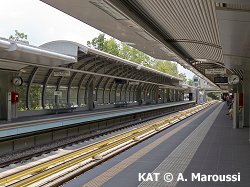
|
| Maróussi | |
| Neratziótissa | |
| Iríni | |
| Iráklio | 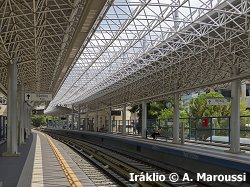 |
| Néa Ionía | |
| Pefkákia | 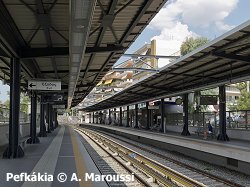 |
| Perissós | 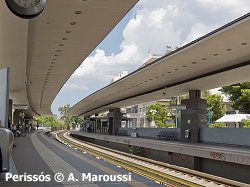 |
| Áno Patíssia | 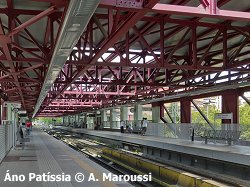 |
| Ághios Elefthérios | |
| Káto Patíssia | |
| Ághios Nikólaos | 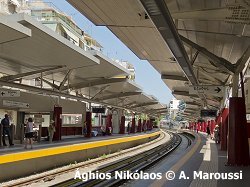 |
|
Attikí |
|
| Victória | |
|
Omónia |
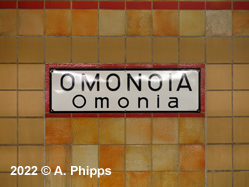 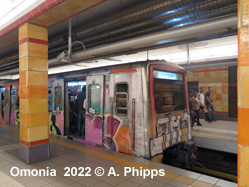 |
|
Monastiráki |
|
| Thissío | |
| Petrálona | |
| Távros | |
| Kallithéa | |
| Moscháto | |
|
Fáliro |
|
|
Piraeus | Pireás |
Accents added for easier pronunciation only!
Text provided Panayiotis Constantinides! Thanks also to Manos Thireos.
2004 © UrbanRail.Net by Robert Schwandl.